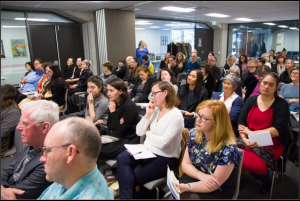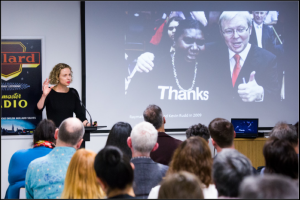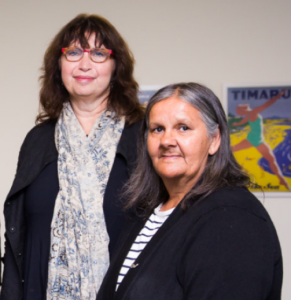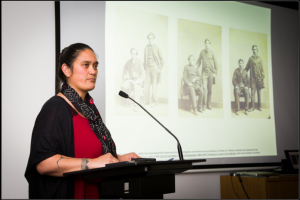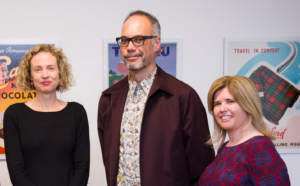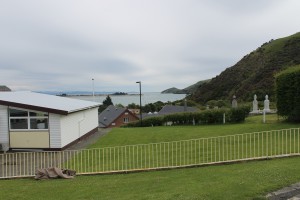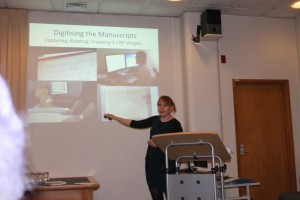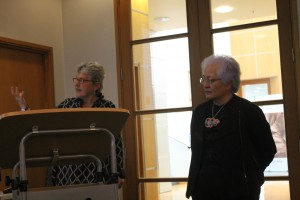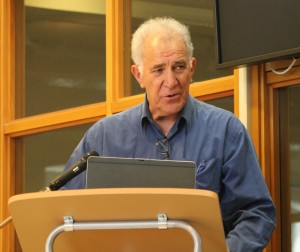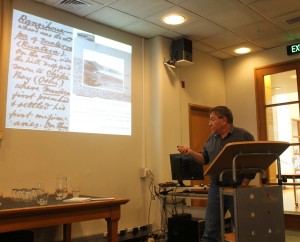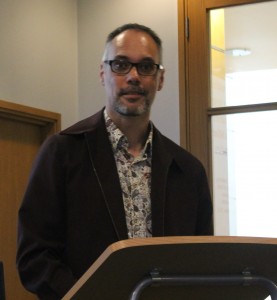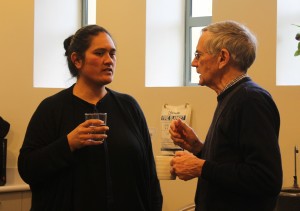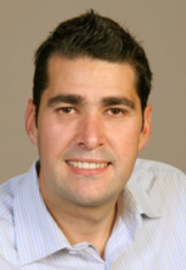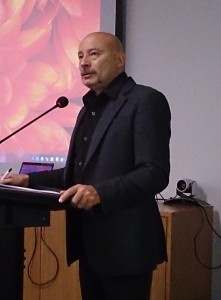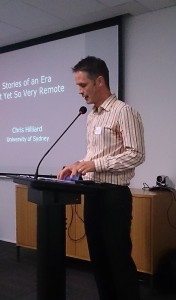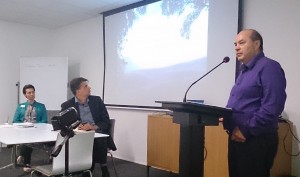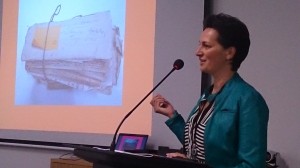CfP. Encounters and Exchanges: Exploring the History of Science, Technology and Mātauranga (Indigenous Knowledge)
Our Centre is supporting this forthcoming conference linked to the Tuia 250 commemoration activities taking place across the country this year. Please consider submitting an abstract. Submission deadline is 8 May.
Call for Papers: Encounters and Exchanges
The University of Otago and the Tōtaranui 250 Trust announce a conference to take place in Blenheim, New Zealand from 1-3 December 2019 that will explore the global history of science, technology, medicine, and mātauranga (indigenous knowledge). The conference will be part of a sequence of national events in New Zealand titled Tuia – Encounters 250 Commemoration. These mark the 250th anniversary of James Cook’s first Pacific voyage and the first onshore meetings between Europeans and Māori.
The conference is especially interested in analysing the implications for the global history of science, technology, medicine, and indigenous knowledge. The two major themes central to the Tuia – Encounters 250 Commemoration, ‘dual heritage-shared future’ and the importance of voyaging, pose a range of questions about knowledge, how it is generated, how it is communicated and translated, and how it is entangled with power. The emphasis on the important role of voyaging is consistent with a recent emphasis in the academic field of the history of science on ‘knowledge in transit’ or how science, technology, and indigenous knowledge – involving people, instruments, tools, communications, values, and epistemology – travel from one region to another and are transformed, reworked or contested. We welcome papers or panels that explore these kinds of questions, either within the specific contexts of the southern Pacific in the 1760s and 1770s, or in any other context where encounters and exchanges were integral to knowledge making.
Building on the ‘dual heritage-shared future’ theme of the Tuia – Encounters 250 Commemoration, conference participants will explore recent efforts to analyse reciprocal relationships, the places where exchanges, negotiations, trade, and transactions have taken place, and the important role of mediators or go-betweens in the history of science, technology and indigenous knowledge. Participants will be encouraged to discuss the value of models for interactions that emphasise such concepts as ‘cultural borderlands’, ‘contact zones’, and ‘trading zones’. The conference will be especially interested in exploring the complex role of indigenous people in the history of science. Recent scholarship has emphasised that local people in all parts of the world not only gathered information but also helped categorize and conceptualize the information. Distinctions between amateurs and professionals as well as producers and users are no longer sharply conceived. As a contribution to the recent emphasis on exploring history of science in a global context, the conference will encourage research covering all parts of the world. The organisers plan to publish selected papers in an edited volume on the global history of science, technology, medicine, and indigenous knowledge.
The conference will include keynotes from leading scholars as well as a programme of special public events in the evenings. Notable participants include Naomi Oreskes, Professor of the History of Science at Harvard University; Jane Lydon, Wesfarmers Chair in Australian History at the University of Western Australia; Peter Moore, author of Endeavour: The Ship and the Attitude that Changed the World (2018 book of the year by the Sunday Times); New Zealand filmmaker Lala Rolls, who will present her feature-length documentary film Tupaia’s Endeavour; Damon Salesa, Pro-Vice-Chancellor, Pacific at the University of Auckland; Matariki Williams, Curator Mātauranga Māori, Museum of New Zealand Te Papa Tongarewa; and critic and former Poet Laureate of New Zealand, Ian Wedde.
This gathering will be held in Blenheim, a small city with a rich cultural heritage and which is surrounded by vineyards and stunning scenery. It will be distinguished by the integral role of local iwi (tribal communities), and participants will have the opportunity to learn about and engage with the knowledge traditions and historical experiences of the tangata whenua (people of the land). This is particularly important as the conference will be a forum for a range of vantage points on how knowledge is created and shared and it will enable genuine and critical reflection on the often painful and contested legacy of Cook’s voyages and the histories of empire and colonization that followed.
To submit a proposal, see the instructions on the conference website
The deadline for proposals is 8 May.
To express an interest in the event or to ask a question, please contact: encounters-exchanges@otago.ac.nz
Travel grants will be available for postgraduate students at New Zealand universities and early-career scholars in New Zealand. If you are interested in one of these travel grants, send an expression of interest to the conference email address as soon as possible: encounters-exchanges@otago.ac.nz. More details will be available later about the formal application process.
REMINDER: CFP, Film in the Colony Symposium
Don’t forget the Film in the Colony Symposium, to be held in Wellington, 13-14 July.
https://blogs.otago.ac.nz/crocc/film-in-the-colony-symposium/
If you are interested in presenting a paper, send a 200-word abstract and a brief bio to: filminthecolony@otago.ac.nz by 28 February 2017.
Stimulating symposium on Indigenous Photographic Histories
Practitioners, curators, archivists, scholars and others flocked to the Indigenous Photographic Histories Symposium held at the National Library in Wellington on 5 November, an immensely successful one-day event co-organized by Paul Diamond (Alexander Turnbull Library), Angela Wanhalla (CROCC/University of Otago) and Jane Lydon (University of Western Australia, Perth).
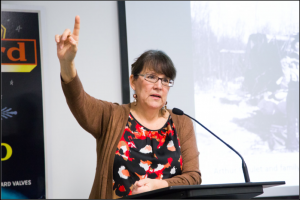
Keynote speaker: Professor Sherry Farrell Racette. Photo: Mark Beatty, Imaging Services, National Library
The symposium kicked off with two keynotes. The first, Professor Sherry Farrell Racette (Manitoba) on “Enclosing some Snapshots”: James P. Brady, Photography and Political Activism, showed how photography was such an integral part of the work of this well-known Métis activist. A self-taught community-based photographer, Brady used it record Metis life at a time when these communities were impoverished and its people lacked rights.
Professor Jane Lydon then gave Aboriginal Transformations of the Photographic Archive on how Aboriginal communities are now using historic photographs. She traced the emotional and healing properties of photographs, and echoing Sherry Farrell Racette’s keynote, pointed to the link between photography, rights and political activism. Drawing upon her Australian Research Council-funded project that identifies and returns Aboriginal photographs held in European collections, Jane noted that while photographs carry the burden of the colonial past, Aboriginal families see them as ways to connect with family and place. To read more about that ARC project have a look at the website: Returning Photographs: Australian Aboriginal Photographs from European Collections
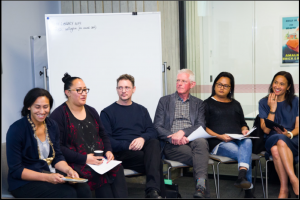
From left: Edith Amituanai, Nina Tonga, Brook Andrew, Paul McNamara, Yuki Kihara, and Jeanette Wikaira. Photo: Mark Beatty, Imaging Services, National Library
After morning tea, a panel of shorter talks ensued, first from three practitioners/artists: Edith Amituanai (Unitec), on the ethics of taking photographs in terms of her own work. Edith spoke about her community-based photography, recording Samoan people and their everyday lives in New Zealand and beyond. She gave us one of the most evocative sentences of the day when she described a photograph as an ‘incomplete utterance of a sentence’; Brook Andrew of Wiradjuri (Monash) discussed the complexities of representation, and his own obsession with the colonial archives, which he uses in his artwork; and Yuki Kihara gave a tour-de-force presentation on the intellectual work underpinning her recent “A Study of a Samoan Savage”, which was inspired by early “scientific” photographs of Samoans in the archive. These were followed by reflections from three people who deal with collections: Paul McNamara on how photographers had utilized the archives in various exhibitions at the McNamara Gallery in Whanganui; Nina Tonga, Te Papa’s Curator Pacific Cultures, on the photography of George Crummer, a trader in the Cook Islands from 1890; and Jeanette Wikaira, Kaituitui Ratonga Māori on how Kai Tahu families interact with the photographic archives of the Hocken Library.
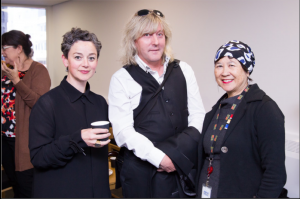
Helen Brown (left) enjoying a break in proceedings with Lyndon Fraser (Canterbury University), and Lynette Shum, Oral History Advisor at the Turnbull. Photo: Mark Beatty, Imaging Services, National Library
The suite of papers reflected on community, place and family. Natalie Robertson of AUT was unable to be at the symposium, but her Siting Mauri through Living Film and Photography using material relating to Ngāti Porou and the Waiapu River was wonderfully and elegantly presented for her by AUT doctoral candidate and photographer Ngahuia Harrison. Helen Brown of Ngai Tahu Archives presented on Wiremu Teira and his Māori Friends where she discussed the Pākehā writer and photographer William A. Taylor and his relationships with Ngāi Tahu communities.
New Zealanders are probably unaware that Aboriginal families, not allowed to live alongside white Australians were relegated to “fringe camps” on the outskirts of outback towns. Karen Hughes (Swinburne University) and renowned Ngarrindjeri weaver Aunty Ellen Trevorrow (Camp Coorong Race Relations Cultural Education Centre) showed life in Ngarrindgeri camps through the intimate and familial portraits made by Aboriginal women photographers.
Chanel Clarke, Māori Curator, Auckland Museum, rounded off the after-lunch session with Dressing the Part: Queen Victoria’s Māori Subjects, on the intersections of dress, photography and colonialism during a visit of Māori to England in the early 1860s. The symposium was lucky to have three “keynote listeners” who all gave their impressions and reflections on the earlier sessions: Damon Salesa (Auckland), Jo Smith (Victoria), and Tina Makereti (novelist, Curator Māori, Museums Wellington). All three touched upon several important themes that united all the presentations: the affective power of photography, the ethics of photography, the rich and varied methodologies being deployed, and the ongoing power of colonial images in the present day.
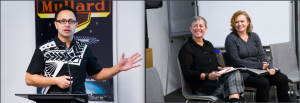
Wonderful “keynote listeners”: Damon Salesa, Jo Smith, and Tina Makereti. Photos: Mark Beatty, Imaging Services, National Library
It was wonderful to be exposed to insights from so many indigenous scholars and practitioners. It was also gratifying to hear how indigenous communities are now using the photographic archives, even those heavily underlain with the violence of colonialism, for their own purposes, as art, for rediscovering histories, and reconnecting communities.
A World History of Bluff
Michael Stevens, one of the Centre’s members, has had his research on the world history of Bluff featured on the University of Portsmouth’s Port Towns and Urban Cultures Project website recently. This site features research that fits the research group’s goals of “furthering our understanding of the social and cultural contexts ports across the globe from the early modern period. It recognizes the importance of ports as liminal places where marine and urban spaces converge, producing a unique site of socio-cultural exchange that reinforced and challenged identities, perceptions and boundaries.” It’s great to see Mike’s fantastic project on Bluff and its port getting international coverage. Well done Mike!
Two MA scholarships offered
Are you interested in New Zealand history? Are you looking for scholarship funding? If you have a BA (hons) first class in History or Māori Studies then you’re in luck. Two Centre members, Michael Stevens and Angela Wanhalla, are seeking applicants for MA scholarships attached to their respective Royal Society of New Zealand research projects. See the details below for further information.
MA Scholarship in New Zealand History
History or background of award
The scholarship is attached to a Rutherford Discovery Fellowship project led by Dr. Angela Wanhalla (Department of History and Art History, University of Otago) on ‘The Politics of Intimacy in New Zealand History’, and funded by the Royal Society of New Zealand.
Purpose of award
Applications are invited from suitably qualified students interested in working on an aspect of private life and the law, particularly associated with the governance and control of marriage in New Zealand, during the nineteenth and/or twentieth centuries. Potential areas of investigation include, but are not limited to: marital violence; bigamy; arranged marriage; customary marriage and the law; cross-cultural relationships and the law; Māori marriage; co-habitation; marital property.
Selection criteria
The successful applicant will have a BA honours (first class), or equivalent in History. A background in New Zealand history is preferred.
Number of awards offered
One
Value
$16,000 stipend, plus tuition fees
Tenure of award
One year, or two years part-time.
Start date:
You may begin the thesis at any stage during 2015, or by 1 July 2016 at the latest.
Further Information
Please send a cover letter, a copy of your academic record, a thesis proposal, and a sample piece of writing to Angela Wanhalla (angela.wanhalla@otago.ac.nz) by 22 June.
MA Scholarship in New Zealand History
History or background of award
The scholarship is attached to a Marsden Fast-Start project led by Dr. Michael Stevens (Department of History and Art History, University of Otago) entitled ‘Between Local and Global: A World History of Bluff’, which is funded by the Royal Society of New Zealand.
Purpose of award
Applications are invited from suitably qualified students interested in working on an aspect of maritime history, ideally with a focus on southern New Zealand and/or with a strong Māori focus, during the nineteenth and/or twentieth centuries. Potential areas of investigation include, but are not limited to: cargo handling; port development (e.g. reclamation; pilotage; built environment); boat-building; commercial fishing; crew culture; marriage patterns; mahinga kai; gendered occupations; intergenerational family businesses; associational culture; religion; class conflict (e.g. strikes and lockouts).
Selection criteria
The successful applicant will have a BA honours (first class) or equivalent, in History or Māori Studies. A background in New Zealand history is strongly preferred.
Number of awards offered
One.
Value
$16,000 stipend (paid in monthly installments), plus tuition fees.
Tenure of award
One year.
Start date:
You may begin the thesis during any stage of 2015, or by 1 March 2016 at the latest.
Further Information
Please send a cover letter, a copy of your academic record, a thesis proposal, and a sample piece of writing to Michael Stevens (michael.stevens@otago.ac.nz) by 22 June.
Indigenous Mobilities Symposium
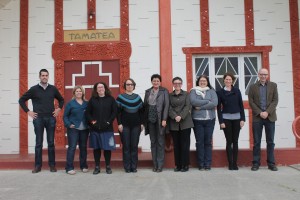
From left, Michael Stevens, Angela Wanhalla, Jane Carey, Kristyn Harman, Regina Ganter, Rachel Standfield, Shino Konishi, Tiffany Shellam, Tony Ballantyne. (Lachy Paterson photographer).
On Thursday and Friday (20-21 Nov) scholars assembled at Ōtākou marae, on the Otago Peninsula near Dunedin, for a pre-read symposium, “Rethinking Native Spaces: Indigenous Mobilities Across and Beyond the Antipodes”, co-organized by the Centre for Research on Colonial Culture of University of Otago and the Monash Indigenous Centre of Monash University. Attending were Tony Ballantyne, Michael Stevens, Angela Wanhalla and Lachy Paterson from CROCC and Rachel Standfield of MIC as well as Shino Konishi (University of Western Australia), Kristyn Harman (University of Tasmania), Tiffany Shellam (Deakin University), Regina Ganter (Griffith University) and Jane Carey (University of Wollongong). Unfortunately Lynette Russell of MIC was unable to attend. Research presented focused on a number of different aspects of Māori and Aboriginal travel in the colonial period, both within New Zealand and Australia but also further afield. A publication is planned. CROCC would like to acknowledge Rachel Standfield in particular for her hard work in bringing this event to fruition.
Celebrating Marsden
It’s been a busy few days at the Hocken Collections with the events around the Marsden Online Archive launch and opening of the associated “Whakapono, Faith and Foundations” exhibition, timed to coincide with the bicentennial of the arrival of missionaries in New Zealand.
Considerable publicity had led to these events. For example:
Tony Ballantyne interview on National Radio
Television One News coverage (watch from 17.37)
Te Karere coverage (i roto i te reo Māori – in Māori)
For all the links see the Marsden Online Archive Storify page.
On Thursday afternoon Kāi Tahu and locally-based Northland Māori welcomed Hongi Hika, a self-portrait sculpture by the illustrious Ngā Puhi warrior. Bernard Makoare and Hinerangi Himiona of Ngāpuhi and Chanel Clarke, Māori Curator of the Auckland War Memorial Museum, accompanied this taonga who was installed in the Whakapono exhibition upstairs in the Hocken Gallery. Click here for the full story.
In the evening a good crowd assembled in the Hocken foyer for both the opening of the exhibition and the official launch of the online archive. The event was opened by David Ellison of the Puketeraki Rūnanka of Kāi Tahu, Bernard Makoare, and Kelvin Wright, Anglican Bishop of Dunedin. Particular praise was given to Gordon Parsonson, present in the front row of the audience, whose painstaking work transcribing the Marsden archives over many decades made the creation of the online archive possible.
The Marsden Online Archive was created by the University Library and Hocken Library, with considerable input from Professor Tony Ballantyne and the Centre for Research on Colonial Culture. This will be of great use to researchers interested in early missionary work, Māori-Pākehā interactions, and Māori culture.
The “Whakapono: Faith and Foundations” exhibition runs till 7 February, 2015.
The following two days were given over to “Dialogues”, a symposium on New Zealand’s early missionary history, held in the Hocken Seminar Room organised by the Centre and the Hocken Collections. This was kicked off with Cate Bardwell and Charlotte Brown of the University Library telling the story of how the Online Archive was created, followed with a demonstration of how to get the most out of the collection.
Three well-known religious historians, Allan Davidson (St Johns), Peter Lineham (Massey) and John Stenhouse (Otago) made up the next session. Allan talked on the “dialogue or disputation” in the first Wesleyan mission at Whangaroa; Peter discussed the Anglican moves into the Bay of Plenty/Waikato district in the 1830s, and how this lead to the sacking of the Matamata Mission Station in 1836; and John focused on Octavius Hadfield, his relationship with his Māori parishoners, and how this influenced his opposition to the Crown’s military actions.
After lunch Angela Middleton (Otago) gave an account of the powerful and influential Hariata, Hongi Hika’s daughter, informed by both historical and archaeological sources. Kuni Jenkins (Awanuiarangi) and Alison Jones followed on with a discussion their interpretation of the encounter at Hohi between Ngā Puhi and missionaries in December 1814. In the afternoon Donald Kerr gave an account of Dr Hocken’s collecting, and how he managed to amass so much of the original missionary papers, now housed in the Hocken Collections. Anna Blackman, the Archives Curator at the Hocken, then gave a talk on exploring the Marsden Collection, and earlier archival practice.
In the evening more people assembled for the launch of Angela Middleton’s new book, Pēwhairangi: Bay of Islands Missions and Māori 1814 to 1845. Manuka Henare (Auckland) formally launched the book, along with speeches by the Rachel Scott, Otago University Press publisher, Sharon Dell, the Hocken Librarian, and Paul Diamond, Curator Māori at the Alexander Turnbull Library.
Listen here to Angela’s Radio New Zealand interview, 4 November 2014.
Saturday was a shorter day. Ian Smith (Otago) gave an account of the archaeological dig and Hohi and how this informs our understanding of this first mission site and its inhabitants. Chanel Clarke and Rose Young (Auckland War Memorial Museum) discussed “Taonga Tuku Iho – Objects in Dialogue”, objects from their collection that spoke to the early interactions between missionaries and Māori.
After morning tea, Lachy Paterson (Otago) discussed Thomas Kendall’s dialogues with Marsden and the CMS on developing a working orthography for the Māori language. Paul Diamond (Turnbull) followed on, bringing to light a Māori vocabulary created by the Wesleyan missionary, Rev James Buller, in the 1830s and what this can tell us the Māori language of that time. After lunch, Tony Ballantyne (Otago) rounded off the symposium with a discussion on how applying new techniques from the field of digital humanities can give new historical perspectives, particularly when working with large collections.
“A World History of Bluff”
Last year CROCC member, Dr Michael Stevens won a Fast Start Marsden Award to research how the Southland port of Bluff connected with the rest of the world, and how this impacted on the town (and vice-versa), in particular the local Kāi Tahu people. As the Royal Society stated, “As a “Bluffie” of Kai Tahu descent, Dr Stevens is ideally placed to carry out a research project that is meaningful to both academics and the local inhabitants.” In order to share his on-going research, Michael has created a new website “A World History of Bluff” with an associated Facebook Page.
Dr Angela Wanhalla wins Ernest Scott Prize
At the Australian Historical Association conference in Brisbane last night, 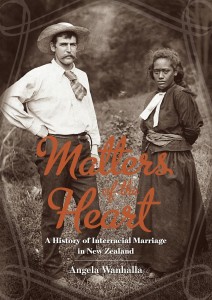 CROCC member Dr Angela Wanhalla was awarded the Ernest Scott Prize for History. This prize is awarded annually to the book judged to be the most distinguished contribution to the History of Australia or New Zealand or to the history of colonization published in the previous year.
CROCC member Dr Angela Wanhalla was awarded the Ernest Scott Prize for History. This prize is awarded annually to the book judged to be the most distinguished contribution to the History of Australia or New Zealand or to the history of colonization published in the previous year.
Matters of the Heart: A History of Interracial Marriage in New Zealand was published by Auckland University Press.
As the judges commented “Angela Wanhalla’s ground breaking history of interracial relationships in New Zealand across two hundred years utilises not only the usual range of church and state records but also personal papers, family and local histories to track the lives of couples whose relationship was sustained over a period of time. While Maori women left little trace for the historian, Wanhalla uses analysis of images, particularly photography, to overcome some of the gaps and silences in the record. She takes a broad view of coupling which incorporates common law relationships, Maori ceremonies and Christian marriages sanctioned by the State and also takes account of various debates and legislative action in relation to marriage over time.
“Wanhalla draws on the recent work by anthropologists and historians such as Ann Laura Stoler to explore the history of emotion and sentiment as central to these encounters. She historicises the specific context in which these are expressed and how they changed over time in relation to the society and demographics. She notes that interracial relationships in New Zealand have often been used as evidence of ‘gentle colonialism’ but while her study of intimacy makes an important contribution to overturning simplistic paradigms of race relations on the frontier and beyond, Wanhalla still emphasises the framework of gendered and racial power struggles within which these relationships operated.”
Congratulations to Angela for her ongoing success!
Cowan Symposium. Cultural Go-Between, Colonial Man: New Perspectives on James Cowan.
A successful one-day symposium was held at the National Library on Friday 21 February, a joint event run by Annabel Cooper of the Centre for Research on Colonial Culture and Ariana Tikao of the Alexander Turnbull Library. It attracted more than 65 attendees, including academics, librarians, archivists, professional and governmental historians, and other interested people. Chief librarian of the Alexander Turnbull Library, Chris Szekely, welcomed people to the event, and suggested that it was a good start to CROCC’s relationship with the Turnbull and National Library, and hopefully the first of many events. Chris’s welcome was followed by a mihi from the Turnbull’s Curator Māori, Paul Diamond.
Chris Hilliard (University of Sydney) returned to Cowan, a subject of research earlier in his career, with the keynote address ‘Stories of an Era Not Yet So Very Remote’ in which he asked us to look beyond Cowan’s grand statements – ones with which he can so easily be tied to the colonial project – to his love of detail, and it was through these that we could get a better understanding of the man. Chris stressed Cowan’s love of New Zealand history, and his connection with place and people.
The themes that Chris set out were picked up by the three speakers who followed. Paul Meredith of Ngāti Maniapoto, like Cowan, grew up in the Kihikihi area, and values the writer’s work, in particular his oral history, as a means of unlocking the voices of his tūpuna. He pointed out too that Cowan collaborated with Raureti Te Huia and the methods they used have parallels with the kaupapa Māori methodology of today.
Te Kenehi Teira of Ngāti Raukawa, Kaihautu Māori for the Historic Places Trust, spoke about the Trust’s development of interpretation and other resources for the Ōrākau commemorations, and a smartphone driving app for the Waikato battle sites. As Te Kenehi said, the app was a means of bringing Cowan into the modern world. The researchers utilised Cowan’s writings as a means of adding detail to the interpretations, and in the case of Ōrākau, of pinpointing the actual site of the pā.
This session was closed by Ariana Tikao of Kāi Tahu, Research Librarian Māori, who discussed the Turnbulls’ recent acquisition and description of 202 folders of Cowan manuscript material (acquired at the end of 2012) that now complements the Library’s existing collection. Ariana also talked about putting together Borderland: The World of James Cowan, (running to 26 April in the Alexander Turnbull Gallery), her exhibition exploring the writer’s life, work and legacy.
After lunch, we heard from Greg Woods who talked on Cowan’s years as a journalist at the Auckland Star (1888-1903). During this time Cowan wrote at least 370 feature articles, some of which he incorporated into his later books. Cowan was a “Māori specialist” perhaps due to his language skills, and unlike most reporters of the time, was able to add his name to these articles. While also shipping reporter Cowan met some famous writers, such as Rudyard Kipling, Mark Twain and Robert Louis Stevenson, and Greg argued that Cowan took Stevenson as a sort of literary model for his writing. Kathryn Parsons, Special Collections Librarian at the University of Waikato, discussed Cowan’s later writing for children in The Enzed Junior, a weekly Saturday supplement that ran from 1934 to 1941. Cowan wrote 255 articles for this publication, 190 of which were on Māori-related topics. Staying with young people, the final speaker in this session, Jim Frood, a history teacher at Kings College, Auckland spoke on the secondary schools history curriculum and the value of Cowan’s work as a resource in the teaching of Year 11-13 history.
Roger Blackley of VUW began the last session with a discussion on Pictures of Old New Zealand, comprising Lindauer portraits of Māori men and women with bibliographical information supplied by Cowan. Roger showed how Cowan re-used text written by earlier writers, such as James Mackay, but moderating some of the sentiments for the sensibilities of his own day. Although Cowan’s writing is about the people, rather than the art itself, Roger argued that Pictures of Old New Zealand might be considered New Zealand’s first art monograph. Lydia Wevers (Stout Centre, VUW) then spoke about Cowan’s travel writing, in particular his work on the Main Trunk Line written for railway tourism purposes. This work shows Cowan’s contradictory attitudes to colonialism, on the one hand accepting the inevitable march of progress, while also lamenting the loss of the bush, and the old Māori ways of life. Annabel Cooper (University of Otago) and Diane Pivac from New Zealand Film Archive, looked at Cowan’s influence on New Zealand films of the New Zealand Wars, from Rudall Hayward (for whom he worked as an advisor) to Geoff Murphy’s Utu, which was inspired by one of Cowan’s stories, to Vincent Ward’s River Queen. We were treated to excerpts from Hayward’s Te Kooti Trail, a silent movie in which Hayward used descendants of the historical figures as actors, and his last movie, Rewi’s Last Stand. Tony Ballantyne (University of Otago and CROCC Director) wrapped up the day, reminding us that Cowan is a more complex personality than superficial reading of his work might suggest.

